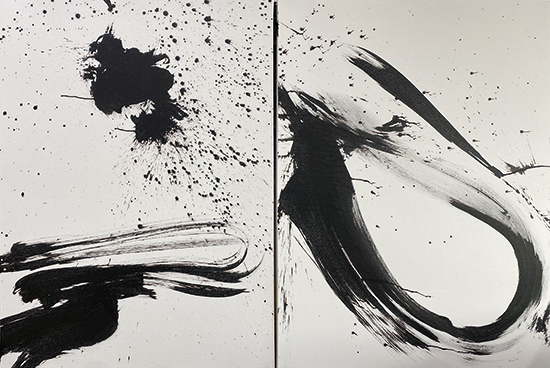HWANG Suk-bong, On board ship 1,2, 2019, Mixed ink on canvas, 97×130cm 2 pieces
동아시아에서 ‘서書’는 중국의 경우 ‘서법(書法)’, 일본은 ‘서도(書道)’로 불리웠지만, 근대 이후 한국은 ‘서예(書藝)’로 불리우며 ‘서書(글씨)가 예술(藝術)이 되는 시대’를 맞이하게 되었다. 해방 이후 화가들은 민족미술의 부흥과 한국적 모더니즘을 창출하는 한 방편으로 서예에 주목하였고, 서예가들 역시 자신들의 작품에 근대 이전 전통시대와는 다른 새로운 근대성을 담아낸 ‘서書’를 쓰고자 치열하게 고민하였다. 최근에는 ‘서書’가 디자인으로서 다양하게 응용되며 서예의 팝아트라고 할 수 있는 캘리그래피(Caligraphy)와 타이포그래피(Typography)가 현대 서예의 새로운 확장성을 보여주기도 한다. 이번 전시는 한국 근·현대 시각문화와 미술에서 서예의 역할과 의미가 무엇인지를 모색하는 국립현대미술관의 서예기획전이다.
In East Asia, the genre of calligraphy has been called shūfǎ (書法; way/method/law of writing) in China and shodō (書道; way/principle of writing) in Japan. In Korea, calligraphy has been called seoye (書藝; art of writing) since the modern era. After liberation, artists paid attention to calligraphy as a means to revive national art and form Korea’s original modernism. Calligraphers, too, were keen to encapsulate new modernity in their brushworks. Recently, calligraphy has been applied in various ways in design. Korean calligraphy and typography, which are considered the pop art of the art of writing, have shown new potential for contemporary calligraphy. Modern and Contemporary Korean Calligraphy, the MMCA’s special exhibition on calligraphy, highlights the roles and meaning of calligraphy in the modern and contemporary visual culture and art of Korea.
